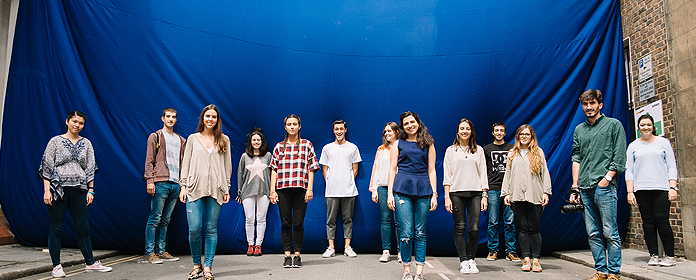A blue cloth divides the School of Architecture into two zones.
The exhibition 'Towards Ithaca. An Architecture of Asylum' reflects the discussion on refugees.

The School of Architecture of the University of Navarra welcomed, last Friday, January 19, the exhibition 'Towards Ithaca. An Architecture of Asylum'. A exhibition developed by students of the School at the International Summer School in London that reflects the discussion on refugees.
The exhibition wants to represent the idea of the border through a blue curtain, which has been hung in the School with the intention of creating a boundary within a space characterized by its continuity and connectivity. "We wanted the visitor to question who is inside and who is outside. Who is the refugee in the migration crises. What differentiates us from refugees and how is it possible to rethink the terms of discussion", explains Alvaro Velasco, former student and professor at the International Summer School in London, coordinator of project.
"We wanted to question how the architect could enter into the problematic and how we could help. We decided to act on the refugee crisis through its most relevant spatial implication, the refugee camp. In this new Odyssey in which the Mediterranean has become a place of doom and a path of hope, London appears as a new Ithaca, a vanishing point or backdrop to the refugees' journey," Velasco has indicated.
A refugee camp in central LondonThe exercise that the third year students of the Global Architecture Program were asked to do during their stay in London at the International Summer School is related to the theme of the Forun 2017 'A world in motion'. It consisted of designing a refugee camp in central London. "The work was approached as a collaborative research among the students. They were divided into four groups, with their corresponding proposals proposing different points of view on a single project and the same issue: refugees," he explained. "On the one hand, the project sought to rethink the idea of the refugee camp; on the other, by shifting the refugee camp from the periphery of the city and society to its center, the proposals attempted to unveil important conditions of the contemporary city."
"In this way, four proposals were born. The virus in the city', which represents the inclusion of the camps, colonizing the most commercial streets of London; 'The monument', which analyzes the different monuments of the city and how they come to define the character of it, trying to introduce into that logic something as alien as the shape of the refugee camp; Tracing a Fence', is the analysis of the limit of the camp, is the importance of the limit and how it can modify a space that before owning it, was equal in all its expansion; and finally, 'Camp Wharf' which criticizes the role that the work has today and how it monopolizes the life of the worker, leaving the rest aside". This was explained by the different students who have been part of this experience.
